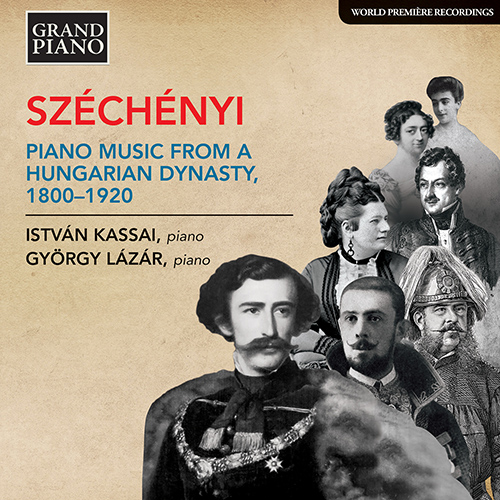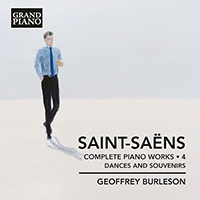
About this Release
“The Széchényi family is one of the most prominent of Hungary’s noble families, and the whole Hungarian nation has much to thank them for. I hope these delightful and enjoyable dances – once their scores have also been published – will find their place in international musical life.” — István Kassai
“This album preserves outstanding and sophisticated music that could become an integral part of pianists’ repertoire. Given that several members of the Széchényi family were extremely accomplished musicians, I feel honoured to be able to contribute something towards the ‘resurrection’ of their works.” — György Lázár
SZÉCHÉNYI
Piano Music from a Hungarian Dynasty (1800–1920)
- István Kassai, piano
- György Lázár, piano
The Széchényi dynasty stood at the heart of Hungary’s political and musical life in the 19th and 20th centuries. Their ideal milieu lay in vibrant, melodious dance-patterned music, of which Imre’s Waltz No. 1 is a perfect example. Ödön’s highly accomplished works reflect his sophisticated wit, whilst in Franciska, Hungary had its first female composer, and in Gisa, the world’s first female film composer.
This recording was made on a modern instrument: Steinway, Model D
Tracklist
|
Széchényi, Félicie
|
|
1
Dorette, Polka française, Op. 4 () * (00:02:52)
|
|
2
Herzblatt (Sweetheart), Polka-Mazur, Op. 1 () * (00:03:46)
|
|
3
Immer lustig (Always Cheerful), Polka française () * (00:02:53)
|
|
4
7 Uhr früh (7 in the Morning), Polka schnell, Op. 3 () * (00:01:43)
|
|
Széchényi, Franciska
|
|
5
6 Ländler () * (00:02:39)
|
|
Széchényi, Lajos
|
|
3 Magyar tántzok (3 Hungarian Dances) () (00:07:00 )
|
|
6
No. 1. — * (00:02:34)
|
|
7
No. 2. — * (00:01:46)
|
|
8
No. 3. — * (00:01:08)
|
|
9
Deutscher mit Coda () * (00:03:35)
|
|
10
10 Ländler und 1 Mazurka () * (00:08:12)
|
|
Széchényi, Ödön
|
|
11
Hajósegyleti Polka (Shipowners Association Polka) () * (00:02:30)
|
|
12
Marien-Polka () * (00:01:59)
|
|
13
Viszontlátási örömhangok keringő (Joyful Sounds of Goodbye, Waltz) () * (00:07:44)
|
|
14
Pull-on! galopp () * (00:02:38)
|
|
15
Regatta négyes (Regatta Foursome) () * (00:04:21)
|
|
16
Ez az élet gyöngyélet, Csilli csárdás (This Life is a Pearly Life) () * (00:03:14)
|
|
17
Hableány polka (Mermaid Polka) () * (00:01:56)
|
|
Széchényi, Gisa
|
|
18
Abendsonne (Setting Sun), Act III: Vorspiel (arr. R. Gound for piano) () * (00:03:23)
|
|
Széchényi, Andor
|
|
19
Ein Marsch mehr! (One More March!) () * (00:02:47)
|
|
20
Gedanken-Walzer (Thinking Waltz) () * (00:06:14)
|
|
21
Tritsch-Tratsch-Polka () * (00:03:10)
|
|
Széchényi, Imre
|
|
22
3 Walzer for piano 4 hands: No. 1. — (1889) * (00:06:01)
|
The Artist(s)
 Kassai has won several first prizes in international competitions such as the International Piano Competition for Young Artists in 1972 in Czechoslovakia, the Piano Competition organised by Hungarian Radio in 1979, and the Paris International Debussy Piano Competition in 1982. Moreover, Kassai’s artistic talent was acknowledged by such prestigious awards as the ARTISJUS-Prize in 1976, the Bonnaud-Chevillion-Prize of the Fondation de France in 1986, the Nívó Prize of Hungarian Radio in 1990, the Ferenc Liszt Prize in 2001 and the Leó Weiner Memorial Prize in 2010. He has been a full member of the Hungarian Academy of Art since 2013.
Kassai has won several first prizes in international competitions such as the International Piano Competition for Young Artists in 1972 in Czechoslovakia, the Piano Competition organised by Hungarian Radio in 1979, and the Paris International Debussy Piano Competition in 1982. Moreover, Kassai’s artistic talent was acknowledged by such prestigious awards as the ARTISJUS-Prize in 1976, the Bonnaud-Chevillion-Prize of the Fondation de France in 1986, the Nívó Prize of Hungarian Radio in 1990, the Ferenc Liszt Prize in 2001 and the Leó Weiner Memorial Prize in 2010. He has been a full member of the Hungarian Academy of Art since 2013. The Composer(s)
 Andor (András) Széchényi was the son of Ödön Széchényi, from his first marriage, to Baroness Almay. He was born in Pest in 1865 and died in 1907, in Nieder-Ollwitz.
He composed dances for the piano, including the Gedanken-Walzer (‘Thinking Waltz’), Ein Marsch mehr! (‘One More March!’) and his Tritsch-Tratsch-Polka, published in 1889 by J. Engelmann, Wien.
Andor (András) Széchényi was the son of Ödön Széchényi, from his first marriage, to Baroness Almay. He was born in Pest in 1865 and died in 1907, in Nieder-Ollwitz.
He composed dances for the piano, including the Gedanken-Walzer (‘Thinking Waltz’), Ein Marsch mehr! (‘One More March!’) and his Tritsch-Tratsch-Polka, published in 1889 by J. Engelmann, Wien.  Félicie Széchényi published her polkas Herzblatt (‘Sweetheart’), 7 Uhr früh (‘7 in the Morning’) and Dorette with the Vienna publishers, Musikaliendruckerei von Jos. Eberle & Co. The Eberle house was established in 1873 and operated under the name Waldheim-Eberle from around 1890. The works must therefore date from between 1873 and 1890. Félicie wrote these pieces in the same year her daughter was born or shortly afterwards, seemingly in the flush of motherhood. Immer lustig (‘Always cheerful’) was published in 1914 by Max F. Aichwalder Musikalienhandlung und Verlag Wien.
Félicie Széchényi published her polkas Herzblatt (‘Sweetheart’), 7 Uhr früh (‘7 in the Morning’) and Dorette with the Vienna publishers, Musikaliendruckerei von Jos. Eberle & Co. The Eberle house was established in 1873 and operated under the name Waldheim-Eberle from around 1890. The works must therefore date from between 1873 and 1890. Félicie wrote these pieces in the same year her daughter was born or shortly afterwards, seemingly in the flush of motherhood. Immer lustig (‘Always cheerful’) was published in 1914 by Max F. Aichwalder Musikalienhandlung und Verlag Wien.  Franciska Széchényi composed works for piano, songs, duets and religious works (liturgical songs, numerous four-part choral works, a German Mass and a Latin Mass), which have all survived in manuscript form. Two of her spiritual songs have been published, appearing in the work Orgeltöne (‘Organ Sounds’) assembled by Ladaslaus Pyrker.
Franciska Széchényi composed works for piano, songs, duets and religious works (liturgical songs, numerous four-part choral works, a German Mass and a Latin Mass), which have all survived in manuscript form. Two of her spiritual songs have been published, appearing in the work Orgeltöne (‘Organ Sounds’) assembled by Ladaslaus Pyrker.  Gisa Széchényi, née Haas von Teichen, wife of Ferenc Széchényi’s great-grandson, the naval officer Gyula, was born in Vienna in 1890, dying there in 1945. Baroness Gisella was the daughter of the industrial magnate Baron Philipp Haas von Teichen. Gisa Haas von Teichen was a beautiful woman with a gift for music, and an excellent pianist. It is said that a number of her admirers once hauled a piano to the top of a mountain for her to play.
Gisa Széchényi, née Haas von Teichen, wife of Ferenc Széchényi’s great-grandson, the naval officer Gyula, was born in Vienna in 1890, dying there in 1945. Baroness Gisella was the daughter of the industrial magnate Baron Philipp Haas von Teichen. Gisa Haas von Teichen was a beautiful woman with a gift for music, and an excellent pianist. It is said that a number of her admirers once hauled a piano to the top of a mountain for her to play.  Count Imre Szechenyi of Sarvar-Felsovidek was born in Vienna in 1825. His father, Lajos Szechenyi, was chief court chamberlain for the Archduchess Sophie, mother of the future Emperor Franz Joseph I of Austria. Because of his father’s position, Imre grew up with Franz Joseph and his brother, later Maximilian I of Mexico. He was educated by private tutors, spoke five languages, played the piano and composed music.
Count Imre Szechenyi of Sarvar-Felsovidek was born in Vienna in 1825. His father, Lajos Szechenyi, was chief court chamberlain for the Archduchess Sophie, mother of the future Emperor Franz Joseph I of Austria. Because of his father’s position, Imre grew up with Franz Joseph and his brother, later Maximilian I of Mexico. He was educated by private tutors, spoke five languages, played the piano and composed music. Reviews
“István Kassai and György Lázár all play with fiery verve and a good deal of humour.” – Piano News







 Grand Piano has gained a reputation for producing high quality recordings of rare keyboard gems. Dedicated to the exploration of undiscovered piano repertoire, the label specialises in complete cycles of piano works by many lesser-known composers, whose output might otherwise have remained unknown and unrecorded.
Grand Piano has gained a reputation for producing high quality recordings of rare keyboard gems. Dedicated to the exploration of undiscovered piano repertoire, the label specialises in complete cycles of piano works by many lesser-known composers, whose output might otherwise have remained unknown and unrecorded.






